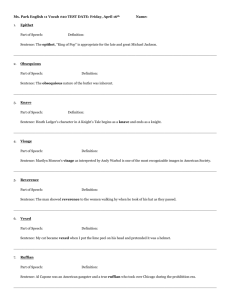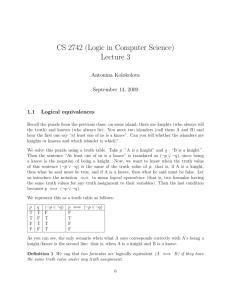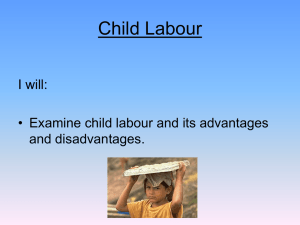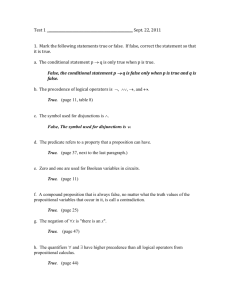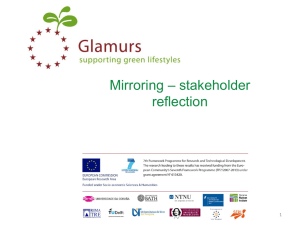The Modernisation of the Public Services and Employment Relations
advertisement
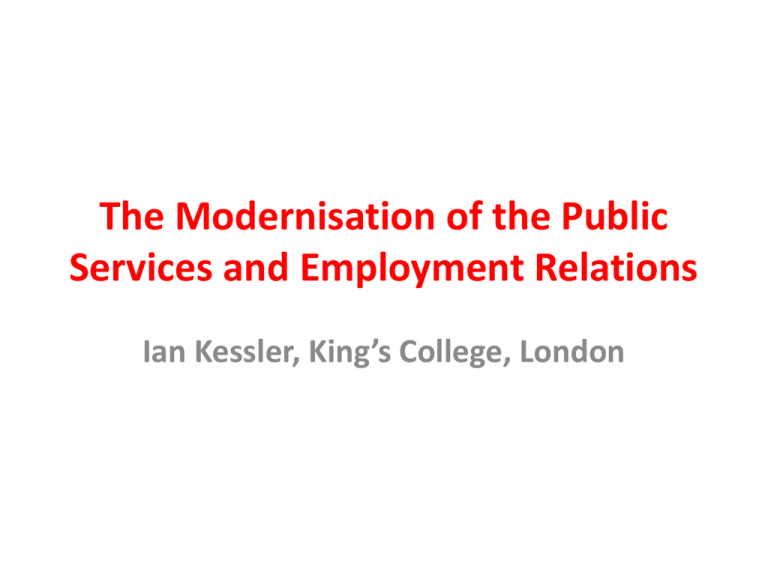
The Modernisation of the Public Services and Employment Relations Ian Kessler, King’s College, London Lamming (2003): LB Brent Social Services • • • • • • Recruitment Difficulties Uncompetitive Salaries Agency Staff Poor Inductions Supervision and Monitoring Workload New Labour: Modernising Government, Cabinet Office, 1999 Government matters. We all want it to deliver policies, programmes and services that will make us more healthy, more secure and better equipped to tackle the challenges we face. Government should improve the quality of our lives. Modernisation of government is vital if the government is to achieve this ambition. David Cameron, Speech of Modern Public Service, Jan. 2011 I want one of the great achievements of this Government to be the complete modernisation of our public services Questions • What is meant by ‘modern (public services)’? • How might the modern connect to employment relations? • How has this connection played itself out in practice? Structure • A Traditional Approach • A ‘New’ Framework • The Framework in Action A Traditional Approach The Public Sector Role of government in delivering good & services Ideological Rational BIG STATE SMALL STATE Directly funded& provided: •Public sector Law making Enforcement Defence Emergency Directly funded •Private sector •Independent sector Welfare benefits Education Environment Health Social Care Neither directly funded nor provided Rail Utilities Housing Others ? UK Public Sector Employment (‘000) Construction Forces Police (incl. civilians Public admin. Of which: civil service Education National Health Service Other health and social work Other (incl. Corps.) Total public sector 1999 111 218 231 1,175 502 1,394 1,207 393 730 5,456 2001 110 218 229 1,196 513 1,418 1,231 400 732 5,531 2003 80 222 249 1,257 557 1,528 1,402 344 792 5,871 2005 75 213 273 1,290 563 1,595 1,515 367 779 6,106 2007 62 200 282 1,285 543 1,630 1,492 360 743 6,052 2009 53 196 293 1,220 525 1,664 1,554 356 974 6,312 2011 46 194 281 1,176 513 1,651 1,591 349 891 6,177 2012 42 187 262 1,091 464 1,600 1,561 323 833 5,899 The Public Sector Employer: Distinctive? • • • • Public money Essential services Political imperatives Distorted/opaque markets forces • Distinctive workforce Profiles of Public and Private Sector Workers (Audit Commission, 2001) Workers in the public sector Workers in the private sector • • • • • • • • - Have more qualifications 44% have at least one degree or NVQ 5. Are more likely to be female and work part time 63% are female /30% part time Are more likely to be on fixed term/temp. contracts More than 10% of such contracts Are older 16% are aged 29 are below 27% 50+ Are more likely to be in a union 59% are union members More the ethnically diverse 15.6% of ethnic minority workers are in health/social work • • • • - Have few qualifications 24% have at least one degree or NVQ5 Are less likely to be female and work part time 42% are female/23% work part time Are less likely to be on fixed/term contracts Under 6% on such contracts Are younger 31% are aged 29 or below 21% 50+ Are less likely to belong to a union 19% trade union members Less ethnically diverse 11.2 of whites in health and social work The Public Sector Employer: Distinctive? Public money Essential services Sovereign Political imperatives Distorted/opaque labour market Distinctive workforce Model A ‘New’ Framework Definition of modern: Relating to the present or recent times as opposed to the remote past (OED) ER & Public Management I945-79 1979-97 1997- 2010 Public Management: Values/Assumptions User Modern Recipient Sovereign Citizen/Consumer Professional Knight Knave Pawn Provider State Private Mixed Hands on Hands off Handy Hierarchy Markets Networks Public Administration New Public Management Governance No Agenda Short Agenda Long Agenda (?) State Structures Management ER: Industrial Relations Work Relations Employment Relations 16 Blair (2010) Bureaucracies are run by people. People have interests. And whereas the market compels change, there is no similar compulsion in the public sector...I had worked out the crucial failure of the first term: the mistaken view that raising standards and performance could be separated from structural reform...I was now clear that public service reform need major structural change. Framework in Action • • • • • New Labour Government Work Relations A (Laudable?) Experiment that Failed How they tried How they failed Work Relations as a Key ER Domain Job regulation relates to the social organisation associated with production processes, including the allocation of tasks and responsibilities, as well as the rules governing the determination of the terms and conditions of employment and their implementation. (Martin, 2003) 19 New Labour Modernization & Work Relations Values Effectiveness • Choice • Voice • Inclusive • Joined up New Labour Modernization Efficiency • Prudent • Consensual • Accountable • Targeted Network Governance • Local Govt Structure/ Management Diversity (High-Low) (incl. Social Care/Education) • Healthcare • Civil Service Work Relations • Professions • Roles • Ways of Working • Actors • Infrastructure 20 Control (Tight-Loose) Professions: From Knave to Pawn? TEACHER SOCIAL WORKER NURSE Dilemma Knave Knight Pawn Tough • Jurisdictions • Capability not Status • Diluted Authority • Choice • Voice • Control Outcomes • Crisis of Identity • Removed • Neutered 21 Love • Reward • Return to Core: Re-Modelling • Deepen Professionalization Work Roles Efficiency Effectiveness NEW ROLES Recast Novel • Teaching Assistant • HCA • CSO • Gateway Workers • Support, Time & Recovery • Emergency Care Practitioner • Parent Support Advisor • Community Development Worker Outcomes? 22 New Ways of Working • Community Engagement – Outreach – Crisis Resolution – Family-Nurse Practitioner • Integration – – – – • Every Child Matters Team Work Multi disciplinary Cross Agency Efficiency – Lean Production – Outsourcing 23 New Actors: Service Users CHOICE VOICE CONTROL User Driven Services Co-Design Co-Production Co-Supervision Users as: • Employer • Worker • Partner ? 24 ? Supportive Infrastructure New Professions New Ways of Working New Roles New Actors INFRASTRUCTURE Capabilities Planning Regulation • Formal • Flexible • Generic • Transferable • Demand/Supply • Sector skills agreement • Training • Accreditation • Safety • Registration 25 ER & Public Management Public Management: Values/Assumptions Coalition? Recipient Sovereign Citizen/Consumer Citizen/ Consumer Professional Knight Knave Pawn Knight (?) Provider State Private Mixed Open: Any Qualified Hands on Hands off Handy Hands-Off Hierarchy Markets Networks (Top Down) Networks (Bottom Down) Public Administration New Public Management Governance (1) Governance (2) No Agenda Short Agenda Long Agenda (?) Confused Agenda User State Structures Management ER: Industrial Relations Work Relations Employment Relations 26 Summary • What is meant by ‘modern (public services)? - Of the time - Different times • How might the modern connect to employment relations? - Interface between ER/PM - Closer links between disciplines • How has this connection played itself out in practice? - New Labour and Work Relations: A Failed Experiment?

